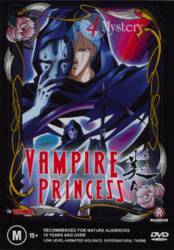Vampire Princess Miyu-Volume 4: Mystery (1998) |
|
Vampire Princess Miyu-Volume 4: Mystery (1998) |
|


|
| BUY IT |
| General | Extras | ||
| Category | Anime |
Main Menu Audio & Animation Credits-Japanese opening title Gallery-Shinma sketches Trailer-(4) Madman propaganda |
|
| Rating |

|
||
| Year Of Production | 1998 | ||
| Running Time | 120:36 (Case: 125) | ||
| RSDL / Flipper | RSDL (72:18) | Cast & Crew | |
| Start Up | Menu | ||
| Region Coding | 4 | Directed By | Toshiki Hirano |
|
Studio
Distributor |
TokyoPop Anime Madman Entertainment |
Starring | None Given |
| Case | Amaray-Transparent-Secure Clip | ||
| RPI | $34.95 | Music | Kenji Kawai |
| Video | Audio | ||
| Pan & Scan/Full Frame | Full Frame |
English Dolby Digital 2.0 (224Kb/s) Japanese Dolby Digital 2.0 (224Kb/s) |
|
| Widescreen Aspect Ratio | None | ||
| 16x9 Enhancement | No | ||
| Video Format | 576i (PAL) | ||
| Original Aspect Ratio | 1.33:1 | Miscellaneous | |
| Jacket Pictures | No | ||
| Subtitles |
English Titling English |
Smoking | No |
| Annoying Product Placement | No | ||
| Action In or After Credits | Yes, next episode trailer after credits | ||
Vampire Princess Miyu Volume 4 is a welcome arrival — I'm really enjoying this series, and it is getting more interesting as it progresses. I've reviewed Volume 1, Volume 2, and Volume 3 so far. Interestingly, Volume 1 held only three episodes, while Volumes 2 and 3 offered four episodes; this Volume holds five episodes.
The episodes on this disc are:
| Number | Title | Description |
| 12 | Garden of Crying Reeds | A young man, who has been looking for his lost cat, makes an unpleasant discovery when he tries to give a kitten to a woman |
| 13 | Light of the Sea, Part 1 | Larva disappears, and Miyu goes looking for him — Reiha and a shinma get in the way |
| 14 | Light of the Sea, Part 2 | Miyu battles several shinma to get Larva back, despite Reiha's "help" |
| 15 | Dream of the Mermaid | After a fight with his girlfriend, a young man turns to a mermaid for comfort |
| 16 | Woman Priest | Miyu does not tolerate the invasion of her country by a Chinese shinma, but she's not happy about the girl who has come hunting it, either |
There seems to be an interest in cats — Garden of Crying Reeds is the second cat-centric episode (the first was Your House, volume three — this one is rather more sympathetic towards cats).
Light of the Sea is quite interesting — it gives us a glimpse into the relationship between Miyu and Larva, revealing that it is rather more complex than it appears on the surface. I hope that we get more insight in future episodes — it makes the series more interesting than a strictly episodic affair. It also gives us more questions, particularly: what is Matsuzake? He is definitely a lot more than just a doll that Reiha carries around, and his opinions, although generally in agreement with hers, are usually expressed more forcefully, as though he compensates for not being able to do anything by talking strongly. The relationship between Miyu and Reiha is hotting up (which can't be to Reiha's advantage — she's a snow demon...).
It appears, watching these episodes, that the one way to convince Miyu not to grant you the gift of eternal happiness is to ask for it.
This series is quite different from any other anime I've watched. It's moody and melancholy in places. About the most cheerful it gets is a quiet calm. For all the violence, it seems almost gentle — a paradox I can't explain. And that's part of the charm...
I must emphasise, in case you haven't read my earlier reviews, that this is a long way from being a series for children. There are few happy endings, and even those are melancholy. This is a dark series, and not one you pop on for a quick look — be prepared to think about this one.
This transfer is presented in an aspect ratio of 1.33:1, as you might expect for a TV series. It is not 16x9 enhanced.
The image is sharp and clear, noticeably sharper and clearer than the previous volumes — the image is really quite attractive to look at this time around. Night scenes are portrayed nicely. There's no noticeable grain and no low level noise.
Colour is excellent; strong and well realised. There are no colour-related artefacts.
There are some minor film artefacts, but they are never troubling. There is a strange smearing effect on the film at 100:23, but you have to be watching very closely to see it.
There is slightly less aliasing this time, but there are still interlaced frames (I think this may have something to do with how the PAL version is produced — I have not heard if the R1 suffers from interlacing). Dot crawl on the black edges of the animation is common, but rarely a bother. There are a few scenes with quite noticeable background shimmer, but it's not too annoying. I find it irritating that the English language credits at the start of each episode show serious jaggies on the sketches of Miyu, but the Japanese credits (in the extras) do not — it's almost as if they used a lower resolution image for creating them.
There are two sets of subtitles in English - the first set only subtitles signs (useful when you're listening to the English dub), the second are full subtitles (for those listening to the Japanese dub who don't speak Japanese) — these subtitles are yellow, easy to read, and seem well-timed. The setup screen makes it easy to select the combination of subtitles and soundtrack you want — any combination is possible. Note that the subtitles do not match the English dub — the dub has been adjusted to better match the character mouth movements.
The disc is single-sided and dual layered, formatted RSDL. The layer change comes at 72:18, exactly in the slot between the third and fourth episodes on the disc — it is the perfect spot for it. Strangely, there is a pause at the start of the closing credits in several of the episodes — this pause looks like a layer change (the run-time counter pauses!), but it isn't, unless this disc has five or six layers... I wonder if this is some kind of not-so seamless branching on the credits, especially considering that the closing credits are now shown over a static image, unlike previous volumes — I preferred the animated closing credits.
| Sharpness | |
| Shadow Detail | |
| Colour | |
| Grain/Pixelization | |
| Film-To-Video Artefacts | |
| Film Artefacts | |
| Overall |
The soundtrack is provided in English and in Japanese, which is ideal for anime (purists can watch the Japanese, others can watch the English). Both tracks are Dolby Digital 2.0, not surround-encoded, at 224 kbps. I listened to the whole of the English track, and to two episodes of the Japanese track. Both tracks sound mostly mono with occasional stereo. The quality of the two soundtracks is equally high, although I definitely prefer the English.
The English dialogue is clear and comprehensible. The Japanese sounds clear enough, but I cannot assess comprehension. There are lots of places where the animated mouths are moving, but there is no Japanese dialogue — it seems quite a bit worse on this disc than on others, but it probably won't bother you too much (it's not too noticeable when you're reading subtitles). The English dialogue is better synchronised to the mouth movements.
The music is a major feature of this series — Kenji Kawai's work is marvellous. Miyu's bamboo flute is haunting, but so is the ocarina being played by Lilith in Light of the Sea.
The surrounds and subwoofer are not used by this straight 2.0 soundtrack.
| Dialogue | |
| Audio Sync | |
| Clicks/Pops/Dropouts | |
| Surround Channel Use | |
| Subwoofer | |
| Overall |
The menu is lightly animated, with music. This disc's menu features Larva.
The opening titles in Japanese (on the feature they are in English). Just as on the previous disc, and the one before. Look at this to see how beautiful the sketches of Miyu are.
Twelve pages of images showing sketches for the shinma in these episodes: Ko Jyoh, Ryu, Nami, Rin Koh, and Koh Waku. The sketches are only labelled in Kanji, unfortunately.
More Madman Propaganda, but a more generous helping this time:
NOTE: To view non-R4 releases, your equipment needs to be multi-zone compatible and usually also NTSC compatible.
The Region 1 version of this disc has the same episodes, but is missing the gallery and trailers. It does have an insert, though, showing designs, which may well provide the content we get in the gallery. I think you could easily be happy with either version of this disc.
A disc with more episodes than previous discs, and a better quality video transfer, too.
The video quality is very good, better than ever before on this series.
The audio quality is not quite as good as previous discs on the Japanese soundtrack, but as good on the English.
The extras are limited, but better than last time.
| Video | |
| Audio | |
| Extras | |
| Plot | |
| Overall |
| Review Equipment | |
| DVD | Sony DVP-NS905V, using Component output |
| Display | Sony VPH-G70 CRT Projector, QuadScan Elite scaler (Tripler), ScreenTechnics 110. Calibrated with Video Essentials. This display device is 16x9 capable. |
| Audio Decoder | Built in to amplifier/receiver. Calibrated with Video Essentials. |
| Amplification | Denon AVC-A1SE |
| Speakers | Front Left, Centre, Right: Krix Euphonix; Rears: Krix KDX-M; Subwoofer: Krix Seismix 5 |